- info@aromantique.co.uk
- 07419 777 451
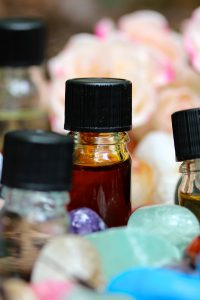 Heather Dawn Godfrey P.G.C.E., B.Sc. (Joint Hon)
Heather Dawn Godfrey P.G.C.E., B.Sc. (Joint Hon)
Gifts of nature, the healing qualities of plants range from physical to ethereal; we are inextricably connected to earths’ web of life.
….you who are born of the mountains and the forests and the sea can find their prayer in your heart. Kahlil Gibran
We share biological affinity with plants; simple examples being gaseous exchange and provision of vital nutrients that maintain and support bodily function, growth, tissue repair, energy production, and more.
In deed, healing plants and their essential oils have been used throughout history for their protective, restorative, rehabilitative, and hedonistic qualities, attributes observed and documented in ancient scriptures and medicinal texts and, more recently, affirmed in scientific journals and numerous research papers. (Godfrey 2022, 2019, 2018)
How essential oils support health and wellbeing
Perfume and incense bring joy to the heart. Proverbs 27:9
Essential oils are aromatic volatile terpene and terpenoid compounds, which are typically extracted from plants (herbs and trees, heart wood, bark, blossoms and flowers, fruits, leaves, stalks, seeds, roots, gums, and resins), mainly by steam distillation, or in the case of citrus fruits, by expression.
The process of extraction increases the concentration of essential oils, thus, their potency too; just one or two drops of essential oil is sufficient to procure significant effect. Applied as an aromatherapy treatment, their molecules are absorbed either via skin (administered in an emollient, such as vegetable oil, cream, lotion or ointment), or the respiratory system through inhalation of their vaporised droplets (applied, for example, via room diffusers, perfumes, or drops on a tissue, steam inhalation, and ‘aromasticks’); inhalation has a direct influence on the limbic (olfactory connection to the brain and neural pathways) and circulatory systems (absorption via alveoli capillaries and thence the organ systems). Certain essential oils are prescribed and administered by professional herbalists, doctors or pharmacists as medicine (contained in gel-like digestible capsules). (Godfrey 2022, 2019, 2018)
Essential oils develop within the plant during the secondary phase of metabolism (along with alkaloids, flavonoids, bitters and gums), a process instigated by photosynthesis. While not vital to the plants existence, essential oils play a significant role. For example, they stave infection, attract pollinators, repel predators, disarm invasive microbes, repair damaged tissue, and control and optimise the ambient environment (temperature and humidity) by creating a haze or mist, an auric vapour, which surrounds the plant (terpenes evaporate at high temperature, and consequently produce air flows that cool the plant and reduce transpiration). They relay messages from one part of the plant to another (thus, they are considered to be ‘hormone-like’), and to other plants in the immediate vicinity. (Godfrey 2022)
Similarly, essential oil molecules modulate various processes within the body. Their properties range across a spectrum, from immune support (anti-bacterial, anti-viral), tissue healing and regeneration, pain relieving, restorative, digestive, to psycho-somatic, revitalising, anti-anxiety, anti-depressant, uplifting, calming and grounding, and more. They are multi dynamic adaptogens (that is, they support the immune system and the body’s resilience to infection, disease and stress); they stimulate the limbic system (the emotional brain) to modulate mood and emotion, and stimulate hormone balance via the limbic systems connection to the pituitary gland. (Godfrey 2022, 2019, 2018)
Olfactory and endocannabinoid receptors
Some of these qualities are attributed, in part, to the affinity certain essential oil molecules (for example, beta-caryophyllene, a-pinene, limonene, linalool, eucalyptol and myrcene – see fig 1) share with the endocannabinoid system – hemp (from which cannabis is derived) contains cannabinoids, also volatile terpenes and phenolic compounds.
Olfactory receptors and endocannabinoid receptors are found scattered throughout the body in numerous organs and tissues (for example, the central nervous system, vascular system, lungs, gastrointestinal tract, reproductive organs, liver, spleen, brain stem, bones and skin). Endocannabinoid receptors are also found in the olfactory epithelium and the main olfactory bulb at the top of the nasal cavity, also the piriform cortex and other brain areas that process and code olfactory information.
Like the olfactory system, the endocannabinoid system plays a role in a range of functions and processes, which include sleep, mood, memory, learning, motor control, skin and nervous function, liver function, muscle formation and food intake, and interacts with the olfactory system to modulate processes such as odour sensitivity, olfactory learning and memory. However, the mechanisms by which endocannabinoid and olfactory receptors interconnect and interact are complex and still not completely realised; in deed, olfaction is an intricate process (see ‘scent detection and the olfactory system’ below).
Fig 1. Terpenes found in Hemp (Cannabis), CBD oil, and Essential Oils
beta-caryophyllene – activates CB2 (Cannabidiol) receptors which modulate immune cell function, pain relief and inflammation (also found in Black Pepper, Clove Bud, Melisa (Lemon Balm), and Ylang Ylang).
a-pinene – modulates pain relief and inflammation, promotes relaxation, aids memory and respiratory function, and supports the immune system (anti-oxidant and anti-infectious) (also found in Frankincense sacra, Cypress, Helichrysum (Immortelle), Juniper berry, Myrtle, Nutmeg, Pine, and Rosemary).
limonene – modulates the immune system, modulates inflammation, anti-tumour, eases bronchial conditions and soothes allergies (also found in Bergamot, Caraway, Grapefruit, Black Pepper, Bitter Orange, Lemon, Mandarin, and Palo Santo).
linalool – modulates pain relief and inflammation, supports the immune system (anti-infectious), protects the nervous system, eases anxiety and depression (also found in Basil linalool, Clary Sage, Coriander, Hyssop linalool, Lavender, Marjoram linalool, Neroli, Petitgrain, Thyme linalool, Ho Wood, and Ylang Ylang).
eucalyptol (1,8-cineole) – modulates inflammation and cytokine activity, supports the immune system (anti-oxidant, anti-infectious), eases chronic respiratory conditions and other chronic diseases (also found in Eucalyptus, Cajeput, Caraway, Ginger, Hyssop officinalis, Spike Lavender, Myrtle, Niaouli, Rosemary, Spanish Sage, and Tea Tree).
myrcene – supports the immune system (anti-oxidant, anti-infectious), eases neurological conditions (such as dystonia, epilepsy and Parkinson’s disease), and promotes relaxation (also found in Rosemary, Juniper Berry, Frankincense sacra, Lemongrass, and Yarrow).
(See my book Healing with Essential Oils to discover more about the chemical constituents found in essential oils.)
The olfactory system and scent detection
Be like the flower, turn your face to the sun. Kahlil Gibran
Scent molecules (terpenes and terpenoids) are detected (like a key in a lock) by olfactory receptors located at the top of each nasal cavity that, in turn, relay nerve impulses to the Limbic System located in the brain. As previously observed, odour receptors are also located in other areas of the body, such as the skin and other organs (heart, liver, lungs, kidneys and gastrointestinal tract). However, by grand design, it seems, proximity of the master olfactory portal in the roof of the nasal cavity ensures immediate awareness and instinctive reflexive responses.
The Limbic System incorporates various functional structures located in the central paleomammalian area of the brain (which include the amygdala, hippocampus and hypothalamus) that are responsible for basic physiological and emotional responses to sensory stimulation. The hypothalamus functionally connects the Limbic System to the frontal lobe (where the brain rationalises and makes sense of information and sensory input) and to the pituitary gland. The pituitary gland, also known as the master endocrine gland, initiates hormone release in response to sensory signals, activating either the sympathetic or parasympathetic nervous system, depending on the nature of the stimuli; the sympathetic nervous system prepares the body for ‘fight or flight’ (protection), and the parasympathetic nervous system maintains a state of peace and relaxation (rest and digest), and disengages the sympathetic nervous system post ‘alert’, returning the body to its optimal functional resting state.
When inhaled, some essential oil molecules will cross the blood brain barrier (especially sesquiterpenes, which are found, for example, in frankincense, carrot seed, cedarwood, German chamomile, ginger, helichrysm, myrrh, black pepper, patchouli, spikenard, and ylang ylang) where they interact with various receptor sites, such as, GABA and glutamate receptors, located in the hippocampus, thalamus, basal ganglia, hypothalamus, and brainstem (GABA is an amino acid that functions to reduce neuronal excitability by inhibiting nerve transmission).
The mechanisms by which essential molecules are absorbed and interact within the body are very complex and, although modern technology affords much insight, are still not fully realised. However, our body is clearly ‘wired’ to receive phyto-molecules; verified by the presence of numerous (olfactory and endocannabinoid) receptor sites scattered throughout the body and the multilateral physical and psychosomatic responses instigated by detection.
(Godfrey 2022, 2019, 2018)
Healing with Essential Oils
Rose (Rosa centifolia/damascena) provides a lovely example of how diverse the action of essential oils can be. The qualities of rose range from hedonistic, aphrodisiac, anti-depressant, hypnotic, and anti-convulsive, to anti-oxidant, anti-inflammatory, analgesic, antitussive (relieves coughs), antibacterial, and bronchodilatory.
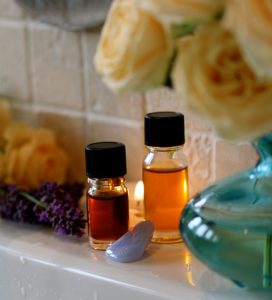 Some of the molecules found in rose oil are barely detectable yet these synergistically contribute significantly to its scent and therapeutic properties (synergy is not unique to rose oil as most essential oils demonstrate synergistic interaction between some or all of their constituents).
Some of the molecules found in rose oil are barely detectable yet these synergistically contribute significantly to its scent and therapeutic properties (synergy is not unique to rose oil as most essential oils demonstrate synergistic interaction between some or all of their constituents).
To illustrate, citronellol and geraniol, are predominant components found in rose essential oil, both of which exude floral, sweet, rose-like scents, yet the perfume of the complete essential oil is acknowledged as rich, intense, sweet, powerful beeswax-like, highly floral, rosy, with waxy, floral, spicy, green, metallic, body notes, then tenacious warm floral spicy dry out notes.
Floral, sweet, rose-like scents are also observed amongst constituent ‘notes’ in other essential oils that contain citronellol (for example geranium and citronella), and geraniol (for example, bergamot, palmarosa, thyme, and geranium). Each molecule comprising an essential oil contributes a unique ‘tone’ that combines with other molecules in various arrangements to create specific ‘tunes’ or ‘melodies’.
(Godfrey 2022)
That which we call a rose, by any other name would smell as sweet. Shakespeare, Romeo and Juliette
Lavender (Lavandula angustifolia) provides another illustration. Linalool and linalyl acetate are two predominant compounds found in this essential oil, collectively making up to 90% of lavenders chemical constituents.
The scent profile of linalool is described as citrus, floral, sweet, woody and green, and linalyl acteate, is described as sweet, green, floral and spicy, with a clean woody, terpy, citrus nuance.
Linalool is sedative, analgesic and anti-inflammatory, and also features in large quantity in other essential oils, such as, ho wood, rosewood, thyme (CT. linalool), marjoram (CT. linalool), and basil (CT. linalool).
Linalyl acetate is anti-inflammatory, sedative, relaxant and anti-hypertensive, and is present in high amount in Clary sage, petitgrain, rose, mints and bergamot FCF essential oils.
Lavender angustifolia’s overall therapeutic profile is, including those qualities mentioned above, anti-depressant, anti-microbial, antiseptic, anti-spasmodic, anti-toxic, anti-viral, bactericidal, cleansing, deodorant, hypotensive, skin healing and toning.
Spike Lavender (Lavandula latifolia), on the other hand, contains linalool and, in place of linalyl acetate, 1,8-Cineole (Eucalyptol) and a lesser amount of Camphor. 1,8-Cineole is expectorant, anti-inflammatory, antispasmodic and improves cerebral blood flow; its scent is ‘eucalyptus-like’. Camphor instigates vasodilation (dilates blood vessels and decreases blood pressure); its scent is fresh and warm. The overall scent profile of Spike Lavender thus differs from Lavender angustifolia and is accordingly described as eucalyptus, herbal, camphor, and medicinal.
These examples demonstrate how intricate and complex essential oils are. Each essential oil comprises a unique array of chemical constituents, the presence and quantity of which synergistically determine and distinguish that oils scent dynamic and therapeutic properties and qualities.
As previously established, essential oils are generally physically protective and restorative and psycho-emotionally vitalising, warming, grounding and calming. Their actions complement and gently support at one and the same time physical, mental and spiritual states.
In deed, the perception of scent instantly instigates a reflexive response within the brain that may inspire mood and emotion, compound and/or trigger memories, and conjure images – a blossoming garden in summer, woody earthy forests in spring, sweet citrus orchards in autumn, – or simply but significantly, instil feelings of peace and calm, of feeling bright and awake, and more.
The sensual experience of scent detection also draws attention to the moment, thus essential oils are wonderful companions for meditation, prayer and for moments when we simply want to centre our attention in the here and now. Thus, they are ideal companions to call upon when dealing with stress and stress related issues, including mild depression, anxiety, feelings of loss and grief, or to journey with through change and transition, or simply to compound and celebrate wellness, wellbeing, a sense of contentment, and joyful events.
The sense of smell is very personal; what one person finds pleasant another person may dislike or feel indifferent toward. Using our own nose, however, we are usually able to detect which scent is good for us at a given moment.
The essential oils listed below are among those most frequently cited as being anti-depressant and anti-anxiety, uplifting and calming. These oils may also alleviate stress related conditions, such as, insomnia, headaches, and skin disorders (eczema, psoriasis and so on), and more.
Essential oils to harmonise mood and emotion
Bergamot
Cedarwood
Chamomile Roman
Citronella
Clary sage
Corriander
Frankincense
Geranium Rose
Grapefruit
Lavender
Lemon balm (Melissa)
Lemongrass
Marjoram
Neroli
Orange
Patchouli
Peppermint
Petitgrain
Rose
Rosemary
Sandalwood
Spikenard
Vetivert
Ylang Ylang
Applying essential oils
Remember, do not apply essential oils neat to your skin, but add one or two drops to an emollient, and do not take essential oils internally unless administered, prescribed and monitored by a professional healthcare practitioner.
Vaporising a few drops of essential oils in a room diffuser, or inhaling one or two drops on a tissue or from a nasal inhaler, or applied as a personal perfume infused in vegetable oil ( applied via massage or roller bottle) or cream, are all fun, safe and very effective ways to dispense essential oils in order to experience their scents and benefit from their physical and psycho-emotional gifts.
Self-massage is also a lovely way to apply essential oils (essential oil molecules penetrate the epidermis and find their way into the circulatory system). For example, add three to six drops of essential oil to a vegetable oil or non-perfumed lotion, and then apply, using a rhythmic motion (stroking or circular movements) to face, arms, hands, legs and feet – ideally after a bath or before bed.
Go to your fields and your gardens, and you shall learn that it is the pleasure of the bee to gather honey of the flower, but it is also the pleasure of the flower to yield its honey to the bee. For to the bee a flower is a fountain of life, and to the flower a bee is a messenger of love, and to both, bee and flower, the giving and the receiving of pleasure is a need and an ecstasy. Kahlil Gribran
You will find valuable insight, practical details and reference information about the various qualities of these and numerous other essential oils in my book Healing with Essential Oils, and my other books Essential Oils for the Whole Body and Essential Oils for Mindfulness and Meditation (published by Inner Traditions, Vermont USA and available to purchase from most high street or online book suppliers).
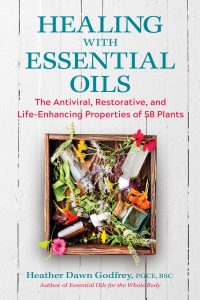
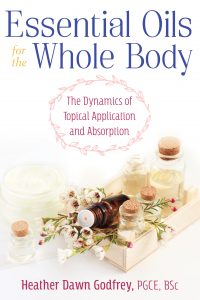
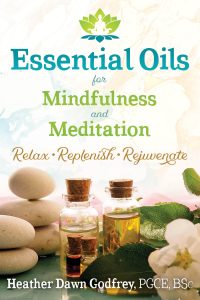
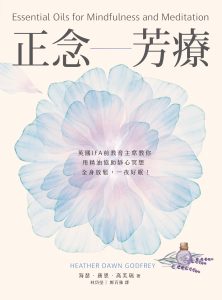
References
Agatonovic-Kustrin, S., Kustrin, E., Morton, D. W. (2019) Essential oils and functional herbs for healthy aging. National Library of Medicine. PubMed. Neural Regen Res. 14(3): 441-445. https://pubmed.ncbi.nlm.nih.gov/30539810/
Ali, B., Al-Wabel, N. A., Shams, S., Ahamad, A., Khan, A. A., Anwar, F. (2015) Essential oils used in aromatherapy: A systematic review. Asian Pacific Journal of Tropical Biomedicine, Elsevier volume 5 issue 8 p 601-616. https://cyberleninka.org/article/n/3650/viewer
Charmine, I. PhD, Oken, B. MD, PhD (2016) Aroma Effects on Physiologic and Cognitive Function Following Acute Stress: A Mechanism Investigation. Journal of Alternative and Complementary Medicine. 1; 22(9): 713-721. https://pubmed.ncbi.nlm.nih.gov/27355279/
Clarke, S. (2002) Essential Chemistry for Safe Aromatherapy. Churchill Livingstone. Harcourt Publishers, London
de Sousa, D. P. (2017) Essential Oils and Their Constituents: An Alternative Source for Novel Antidepressants. Molecules, 20(8): 1290. https://www.ncbi.nlm.nih.gov/pmc/articles/PMC6152054/
do Vale T.G., Furtado E.C., Santos Jr J. G., Viana G.S.B. (2002) Central effects of citral myrcene and limonene, constituents of essential oil chemotypes from Lippia alba (Mill.) n.e. Brown. NIH National Library of Medicine 9(8):709-14. https://pubmed.ncbi.nlm.nih.gov/12587690/
Ebrahimi, H., Mardani, M., Basirinezhed, M. H., Hamidzadeh, A. Eskandari, F. (2021) The effects of Lavender and Chamomile essential oil inhalation aromatherapy on depression, anxiety and stress in older community dwelling people: A randomized Controlled trail. Explore (NY). S1550-8307 (21)00001-X. https://pubmed.ncbi.nlm.nih.gov/33454232/
Emer, A. A., Donatello, N. N., Batisti, A. P., Belmonte, L. A. O., Santos, A. R. S., Martins, D. F. (2018) The role of the endocannabinoid system in the antihyperalgesic effect of Cedrus atlantica essential oils inhalation in a mouse model of postoperative pain. Journal of Ethnopharmacology, Elsevier, vol 210 p 477- 484 https://pubmed.ncbi.nlm.nih.gov/28917977/
Fung, T. K. H.; Lau, B. W. M.; Ngai, S. P. C.; Tsang, H. W. T. (2021) Therapeutic Effect and Mechanisms of Essential Oils in Mood Disorders: Interaction between the Nervous and Respiratory Systems. International Journal of Molecular Science 22(9): 4844
Gibran, K . (1980) The Prophet, Wlliam Heinmann, Pan Books. ISBN 0-330-26220-3
Godfrey, H. D. (2022) Healing with Essential Oils. Healing Arts Press, Rochester, Vermont USA
Godfrey, H. D. (2019) Essential Oils for the Whole Body. Healing Arts Press, Rochester, Vermont USA
Godfrey, H. D. (2018) Essential Oils for Mindfulness and Meditation. Healing Arts Press, Rochester, Vermont USA
Gupta, A., Coogler, G. (sourced June 2021) Traditional plants that engage the endocannabinoid system and their medicinal potential. Canna Foundation (Scientific studies and cannabis testing. https://www.fundacion-canna.es/en/traditional-plants-engage-endocannabinoid-system-and-their-medicinal-potential
Han, X., Gibson, J., Eggett, D. L., Parker, T. L. (2017) Bergamot (Citrus bergamia) Essential Oil Inhalation Improves Positive Feelings in the Waiting Room of a Mental Health Treatment Centre: A Pilot Study. DOI: 10.1002/ptr.5806. 31(5): 812-816. https://pubmed.ncbi.nlm.nih.gov/28337799/
Herz, R. (2016) The Role of Odour Evoked Memory in Psychological and Physiological Health. Brain Science vol 6(3). https://www.ncbi.nlm.nih.gov/pmc/articles/PMC5039451/
Hogratanaworakit, T (2009) The Relaxing effect of rose oil on humans. National Library of Medicine. PubMed. Nat Prod Commun. PMID: 19370942. 4(2):291- 6. https://pubmed.ncbi.nlm.nih.gov/19370942/
Johnson, S. A., Rodriguez, D., Allred, K. (2020) A Systematic Review of Essential Oils and the Endocannabinoid System: A Connection Worthy of Further Exploration. Hindawi Journals. Evidence-Based Complementary and Alternative Medicine.. Article ID 8035301. https://www.hindawi.com/journals/ecam/2020/8035301/
Lillehei, A. S., Halcon, L. L. (2013) A systematic review of the effect of inhaled essential oils on sleep. Journal of Alternative and Complementary Medicine. DOI: 10.1089/acm.2013.0311. 20(6): 441-51. https://pubmed.ncbi.nlm.nih.gov/24720812/
Lizarraga-Valderrama, L. (2021) Effects of essential oils on central nervous system: Focus on mental health. Phytotherapy Research. DOI: 10.1002/ptr.6854. 35(2): 657-679. https://onlinelibrary.wiley.com/doi/full/10.1002/ptr.6854
Maleki, N. A., Maleki, S. A., Bekhradi, R. (2013) Suppressive Effects of Rosa Damascena Essential Oil on Naloxone-Precipitated Morphine Withdrawal Signs in Male Mice. Iran Journal of Pharmaceutical Research. PMCID: PMC3813277. https://pubmed.ncbi.nlm.nih.gov/24250642/
Olofsson, J. K., Ekstrom, I., Lindstrom, J., Syrjanen, E., Stigsdotter-Neely, A., Nyberg, L, Jonnson, Sara, Larsson, M. (2020) Smell-Based Memory Training: Evidence of Olfactory Learning and Transfer to the Visual Domain. Chemical Senses, Oxford Academic volume 45 issue 7 p 593-600. https://academic.oup.com/chemse/article/45/7/593/5869423
Peana, A. T., D’Aquila, P. S., Panin, F., Serra, G., Pippia, P., Moretti, M. D. L. (2002) Anti-Inflammatory activity of linalool and linalyl acetate constituents of essential oils. Phytomedicine. National Library of Medicine. PubMed 9(8): 721-6. https://pubmed.ncbi.nlm.nih.gov/12587692/
Pereira I., Severino P., Santos A.C., Silva A.M., Souto E.B. (2018) Linalool bioactive properties and potential applicability in drug delivery systems. Colloids and Surfaces B Biointerfaces 171:566-578. NIH National Library of Medicine https://pubmed.ncbi.nlm.nih.gov/30098535/
Salehi B., Upadhyay S., Orhan I.E. Jugran A.K., Jayaweera S.L.D., Dias D.A., Sharopov F., Taheri Y., Martins N., Baghalpour N., Cho W.C. Sharifi-Rad J. (2019) Therapeutic Potential of a- and B-Pinene: A Miracle Gift of Nature. Biomolecules NIH National Library of Medicine 9(11): 738 https://www.ncbi.nlm.nih.gov/pmc/articles/PMC6920849/
Sanchez-Vidana, D. I., Ngai, S., P-C, Chow, J. K-W Chow, Lau, B. W-M, Tsoan, H. W-H (2017) The Effectivess of Aromatherapy for Depressive Symptoms: A Systematic Review. Evidence Based Complementary and Alternative Medicine. 5869315. https://www.hindawi.com/journals/ecam/2017/5869315/
Soel G.H., Kim K.Y. (2016) Eucalyptol and its role in chronic diseases. Advances in Experimental Medicine and Biology. NIH National Library of Medicine 929:389-398 https://pubmed.ncbi.nlm.nih.gov/27771935/
Setzer, W. N. (2009) Essential Oils and anxiolytic aromatherapy. Sage Publications, Journal of Natural Product Communications vol 4 no 9 p 1305- 1316.
Terral, G., Marsicano, G., Grandes, P., Soria-Gomez, E. (2020) Cannabinoid Control of Olfactory Processes: The where it matters. PMC7230191. Genes (Basal) 11(4): 431. https://www.ncbi.nlm.nih.gov/pmc/articles/PMC7230191/
The Good Scents Company (accessed July 2021) http://www.thegoodscentscompany.com/data/rw1007872.html
Tisserand, R., Young, R. (2014) Essential Oil Safety 2nd ed. Churchill Livingstone, Elsevier, London
Turcotte C., Blanchet M-R, Laviolette M., Flamand N. (2016) The CB2 receptor and its role as a regulator of inflammation. Springer Cellular and Molecular Life Sciences 73(23): 4449-4470 https://www.ncbi.nlm.nih.gov/pmc/articles/PMC5075023/
Yu L., Yan J., Sun Z. (2017) D-limonene exhibits anti-inflammatory and antioxidant properties in an ulcerative colitis rat model via regulation of iNOS, COX-2, PGE2 and ERK signalling pathways. Molecular Medicine Reports. Spandidos Publications 6241 p 2339-2346 https://www.spandidos-publications.com/mmr/15/4/2339

Heather Dawn: Godfrey. P.G.C.E., B.Sc. (Joint Hon)
Author of Healing with Essential Oils, Essential Oils for the Whole Body, and Essential Oils for Mindfulness and Meditation, published by Healing Arts Press, Inner Traditions USA.
We are surrounded by viruses and other microbes with which we share a symbiotic and, mostly, healthy and supportive relationship. Some microbes are pathogenic, and some become pathogenic if they proliferate without being kept in check. A healthy immune system works in collaboration with viruses and microbes to maintain internal equilibrium and resilience.
COVID-19 is a novel virus with mild to severe symptoms. In most cases people are not even aware they are infected; between 80 and 95% of those infected (depending on their background health) experience no symptoms or mild ‘flu-like symptoms and recover without ill effect. Some people, particularly the very elderly and people who have underlying serious or chronic co-morbidities, experience severe or acute symptoms (a chronic cough, chest tightness, shortness of breath, cognitive dysfunction and extreme fatigue), which may last five to seven days; these symptoms may linger for up to twelve weeks, or even longer in some cases (Post COVID-19 Syndrome).
One of the less severe, but none-the-less distressing, symptoms of COVID-type infection is loss of the sense of smell. Recent research indicates that essential oils have a significant role to play as aids to recovery of viral initiated loss of sense of smell.
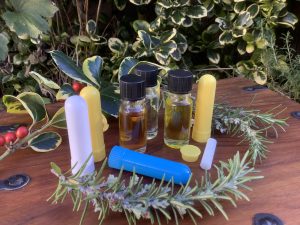 While viral infection may ‘take down’ the ability of olfactory neurons to register scent molecules, some scent molecules can still traverse the epithelium and directly enter the brain. Smelling a scent may evoke memories, feelings and sensations, and inspire imagination, in a way that may begin to re-awaken or stimulate olfactory neural pathways. At the same time, essential oil molecules may also aid tissue regeneration and repair the olfactory epithelium.
While viral infection may ‘take down’ the ability of olfactory neurons to register scent molecules, some scent molecules can still traverse the epithelium and directly enter the brain. Smelling a scent may evoke memories, feelings and sensations, and inspire imagination, in a way that may begin to re-awaken or stimulate olfactory neural pathways. At the same time, essential oil molecules may also aid tissue regeneration and repair the olfactory epithelium.
Putting this to the test, four essential oils (clove, eucalyptus globulus, lemon and rose) were selected for ‘smell training’ exercises. (Hopkins 2021, Hummel 2018, 2009) Between them, these oils express a diverse and complex range of scent nuances, while each essential oil also exudes its own unique and distinctive odour quality. These chosen scents also express odour qualities that correlate with three of the four basic tastes (sweet, bitter and sour). Forty five per cent of smell training participants regained their sense of smell.
Along with their sensual qualities and tissue healing properties, these oils also demonstrate anti-viral and anti microbial qualities, and various psycho-emotional qualities, that may alleviate other post-viral symptoms of COVID-19, such as fatigue, depression, and lack of concentration, while also staving residual infection and averting further viral spread.
To learn more about viruses, essential oils that may support olfactory rehabilitation and/or may alleviate other related conditions or co-morbidites, please refer to my full article here.
Please refer to my books for information about the individual properties and qualities of essential oils, and how to apply them safely and effectively: Healing with Essential Oils, Essential Oils for the Whole Body, and Essential Oils for Mindfulness and Meditation, published by Healing Arts Press, Inner Traditions USA.
References
Hopkins, C. Prof. (8th January 2021) Hope for recovery for loss of smell for COVID patients. Sky News Interview https://www.facebook.com/watch/?v=857906648400464
Hummel, T. (2018) A simple flu, and simple infection: how effective is smell training at curing infection? BCC News interview. https://www.bbc.co.uk/news/av/science-environment-46386497
Hummel, T., Rissom, K., Redden, J., Hahner, A.,Weidenbecher, M., Huttenbrink, K-B. (2009) Effects of Olfactory Training in Patients with Olfactory Loss. Laryngoscope. https://onlinelibrary.wiley.com/doi/abs/10.1002/lary.20101
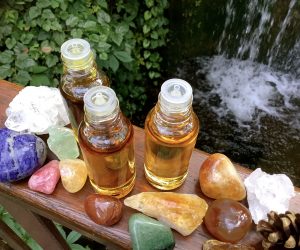
Aromantique incorporates three dynamic strands: my essential oils book series, workshops and training, and essential oil treatments
So far, I have published three of a series of books exploring the virtues of essential oils: Healing with Essential Oils, Essential Oils for the Whole Body, and Essential Oils for Mindfulness and Meditation (all winners of the Janey Loves Platinum Awards) through Healing Arts Press (Vermont USA). Essential Oils for the whole Body and Essential Oils for Mindfulness and Meditation are also published in traditional Chinese.
My clinic is located in Lyme Regis, nestled on the south Jurassic coast at the border between East Devon and West Dorset. Thus, my clients tend to be a mix of holidaymakers and local residence.
When teaching, I prefer to work with small groups, as this enables valuable experiential interaction: exploring scent dynamics and creating perfumes and remedies, among other elements.
As my age determines, I have travelled a long and varied road. I learnt to meditate in the early ‘70’s, when I was a teenager, and, at the same time, serendipitously, was introduced to complementary medicine (or ‘alternative medicine as it was coined then). During this period, I met and worked for Robert Tisserand, who introduced me to essential oils. I also met other practitioners who introduced me to acupuncture, homeopathy, and osteopathy; I was young and fascinated, this was a whole new ‘world’ to me.
I have four grown up children, who now have children of their own. While my children were small, I did various part time jobs that enabled me to juggle being a mother and to work to ‘help make ends meet’. For example, I was ‘Arts Coordinator’ for my local Council funded Arts Association, and also worked for a T-shirt printing company, among other jobs. I was a parent governor, and also stood as a candidate during local elections for the Green Party.
As my children began to grow, I picked up the threads I began to weave earlier, and completed a B.Sc. degree in Counselling and Complementary Medicine, and Masters’ modules in Mindfulness, and Supervision of Counselling, at the University of Salford, and a Post Graduate Certificate of Education at Bolton Institute. During this time, I set up my aromatherapy practice and also taught at local FE Colleges: subjects, for example, included ITEC aromatherapy and reflexology, diet and nutrition, and PTLLS (Preparing to Teach in the Lifelong Learning Sector). I accepted a post at the University of Salford, in the School of Health Science and Social Care (now the School of Health and Society) as Programme Lead for the B.Sc. Integrated Therapy in Practice , and Complementary Therapy in Practice, degrees, and Module Lead for Aromatherapy, and Supervision and CPD, among other roles. I worked at the university for a number of years as part of a team delivering degrees that straddled Complementary Medicine, Health Sciences and Counselling. My specific interest (then and now) was the psycho-emotional influence of essential oils and their consequential influence on health and wellbeing (my B.Sc. dissertation explored The Role of Essential Oils in the Management and Treatment of ADHD, and my Masters assignment explored Essential Oils and Mindfulness and The role of Professional Supervision in Therapeutic Relationships).
My books are an accumulation of years spent studying, teaching and working in this field. Essential oils seem to embrace so many dynamics – creative, artistic, sensual, emotional, healing and nurturing, and have led me to delve into interesting aspects – organic chemistry, botany, pathophysiology. I am, in truth, a perpetual student – the adage ‘the more you learn, the less you know’ seems so true (and is actually very exciting).
I moved from Lancashire to Dorset nine years ago; the south-west being where the roots of my extended family are (dad, a ‘Devon lad’ joined in the RAF as a teenager, met my mother, ‘a Dorset girl’, and subsequently my brother, sister and I spent our childhood and teenage years travelling with our parents wherever dad was posted). Lyme Regis sits neatly at the boarder between both counties.
It’s a no-brainer. It’s impossible to be involved in complementary medicine and to not realize the intrinsic connection we have with our environment and nature; that everything is, in deed, interconnected; that we are influenced by what we eat and consume in various ways; and that we, in turn, influence the environment around us through our actions and behaviours. We are part of, not separate from, nature; we are inter dependent – for example, the slightest change in levels of oxygen in the atmosphere and we would cease to exist; our bodies cannot function without the nutritional input gifted by nature. Experiencing respect and reverence is as important to our souls as feeling unconditional love; these conditions are, in fact, I believe, expressions of that love.
I selected my publisher, Inner Traditions, not just because they release amazing books in my genre, but also because they uphold environmentally supportive values (for example, https://www.innertraditions.com/greenpolicies).
Equally, I select suppliers whose oils and products are ethically sourced and, as often as possible, organic; especially important when purchasing optimum quality essential oils (for example, NHR Organic Oils , Oshadhi UK) – all-be-it ‘out there’, there is something about the energy and therapeutic quality of oils that are appropriately, respectfully sourced and distilled. As well as appropriately grown and sourced plant material, appropriate length of distillation time, pressure and temperature are significant to the resultant quality of the essential oil. Sometimes, this means paying a little more for the oils I purchase, but if that payment supports this practice and finds it’s way back down the chain in fair remuneration to everyone involved, so we are all able to benefit and support each other, then so be it. Quality and reliability are paramount with regard to my therapeutic practice.
My feeling is not to compete (which may seem counter-intuitive in a competitive environment), but to do what I do well, to meet and walk, share and exchange, laugh and love, with fellow travellers, on this amazing journey through life. We each have special gifts to share and express, and I believe that when we follow our passion, we simply shine, for all to see. My passion is ignited by the creative, sensual joy that scent can inspire, and how the multi dynamic qualities of essential oils influence health, healing and wellbeing.
Positive and supportive. For example:
Heather is a very talented and experienced aromatherapist, she intuitively blended a sublime mix of oils specifically for me and gave an amazing massage. I left with both my body and mind relaxed and rejuvenated. An absolutely delightful experience, thank you Heather.
Jess B.
Wow! Went to Heather for a massage last week. It was an amazing experience, incredibly relaxing, and very healing. Heather is incredibly professional, whilst at the same time, extremely warm and welcoming, instantly putting you at ease. The treatment took place in her studio, which is warm, cosy and peaceful. A full body massage is just that and I felt that every part of my body benefited from the gentle massage using the essential oils that Heather and I chose together. By the end of the session I felt as though I had been wrapped in a little cocoon and was very reluctant to leave! Have already booked my next treatment. Thank you so much, Heather. I shall be recommending you to all my friends x
Clare S.
And from. my readers:
Healing with Essential Oils
Heather Dawn Godfrey’s highly recommendable book gives a grounded scientific knowledge on essential oils and at the same time all the practical advice one needs to use them efficiently to restore and maintain health.
Christopher Vasey ND
Author of Natural Antibiotics and Antivirals
A brilliant and informative ‘must-have’ book for anyone looking for a natural way to heal, restore and create harmony and balance in their life.
Sue Stone
Author, TV Presenter and Transformational Leader of the Sue Stone Foundation
This book is dynamic for the student who is interested in the science aspect of aromatherapy. She takes you from seed to distillation and breaks down in detail the chemical composition of each oil profiled and actions offered. A solid reference work.
Candice Covington
Author of Essential Oils in Spiritual Practice
Healing with Essential Oils, like Heathers other books, is aimed at those who apply essential oils in their everyday life, students and professional practitioners alike. We don’t all have time or resources in our busy demanding lives to engage in professional training. Heathers book provides a wonderful accessible resource that sets a sound foundation to support your application of essential oils, from which you can grow and develop your learning.
Whether you already use essential oils at home for your own pleasure, integrate them as an aspect of professional beauty, wellness or health practice, or as artistic and aesthetic ingredients, or are simply intrigued and want to know more about essential oils, this book is written for you.
Janey Lee Grace
Author of Happy, Healthy, Sober, TV and Radio Presenter
Essential Oils for the Whole Body
An impressive and comprehensive presentation of what essential oils are, how they work, and how to use them, not only for physical illnesses but also on the psycho-emotional level. A great book on essential oils!
Christopher Vasey, ND, author of Natural Antibiotics and Antivirals
In times when most aromatherapists are going back to using simple recipes based on the biomedical paradigm, this book opens up another way of looking at topical applications and absorption dynamics. These areas are actually more complex than mechanical interpretation allows and require a book with a holistic, and even spiritual, background combined with scientific insight. It will surely build stronger relationships with the ‘whole body’.
Martin Henglein, Naturopath, Aromatherapist, and Osmologist
This book offers a beautiful bridge between the science of aromatherapy and esoteric application. Godfrey presents a truly holistic approach that explores how to support the whole self, from the physical to the emotional and spiritual.
Candice Covington, author of Essential Oils in Spiritual Practice
A lovely book packed full of information about the form and function of the human body and the ways essential oils can interact with it. This book builds on the author’s previous work, Essential Oils for Mindfulness and Meditation, to create an invaluable guide for those who wish to understand essential oils and use them creatively and safely.
Sophie Olszowski, PhD, director of SPZ Associates Ltd.
I am an avid believer in using essential oils in many different aspects of body health and home use so I was thrilled to receive this book for review. What I found here is a great complete education on Essential Oi . The author has included blending of oils, safety as well as even the chemical contents, which are good to know for those of us that use oils in our daily lives. I highly recommend the instructions for making creams, ointments and skin care product’s, which was so fun to learn so much more then I knew. The recipes are brilliant and easy to follow. There is also information on diffusing oil’s, which I am already using and enjoying. A ‘definitive’ book on essential oils this book I highly recommend for all who use oils and wish to educate themselves on both the oils, the process and the creation of recipes. Out of all the books on Essential Oils I have read over the years this is my favourite.
C.C. Netgalley
The content of this book is full of very descriptive information about essential oils. It would make a great reference book in any home as well as the local public library. This book would also be a well-used addition to any person wanting a more in-depth knowledge of oils. It will also help those like me who dally somewhat with oils but do not fully comprehend all the intricacies. Might keep someone like me from handling the oils improperly.
Mary. Goodreads
This book is a great resource for anyone wanting to dig deeper into essentials oils, you get tons and I mean tons of resourceful information I cannot express how much detail and research this author did just for this book. You get recipes, for creams, lotions, and perfume oils. The author doesn’t only use essential oil, but she also gives you a list of gemstones to use every day, you get worksheets and much more to help you in your study and lifestyle.
Laurie. Goodreads.
Essential Oils for Mindfulness and Meditation
There is a unique way to enhance psychological well-being waiting to be explored. This book tells you how meditation and aromatherapy, classic tools for modifying the mind, can work together to maintain a state of calm and insight. Familiar oils like rose and frankincense add serenity and inspiration to the practice of mindfulness meditation. Diffusing an essential oil during meditation practice can even return your awareness to that meditative mode if you smell the aromatic oil again later.
The author is an aromatherapist who not only uses essential oils professionally but also conducts research into the effects of these powerful plant ingredients. The reader will find out how knowledge of traditional practice and subjective experience, backed by scientific evidence, is an ideal path for discovery; how mindfulness meditation and essential oil inhalation relieve anxiety or calm the mind, as explained from the perspectives of ancient history, religious practices, and modern complementary medical practice. Scientific studies involving human subjects and essential oils tested in laboratory models are described in easy-to-digest detail that adds value and validity.
Advice on how to use the pure essential oils comes with a thorough briefing on dose and safety–a prerequisite for these concentrated and potent plant extracts. In passing, learning about the many everyday food, drink, and cosmetic products that contain essential oils is an eye-opener on the hidden influences on the mind and body. This book is bound to have a long-lasting impact on both meditation and aromatherapy practices, thanks to its inspired author, Heather Dawn Godfrey.
Elaine Perry, Ph.D., professor emeritus of neuroscience at Newcastle University
Essential Oils for Mindfulness and Meditation fills an important gap in the field of essential oils. Where many other books are contented with the properties and the handling of oils, Heather Godfrey provides us with a profound scientific background of the different oils and opens up the field toward awareness and meditation. This book is a wonderful guide to using essential oils as valuable helpers for everyday life, as a source of knowledge for well-being professionals, and for a deeper understanding of oneself and nature.
Ewald Kliegel, author of Crystal Wands and Holistic Reflexology
This interesting book melds the science and alchemy of essential oils and their use in meditation with a mix of personal anecdotes and evidence. Taking the reader on a journey through these highly topical disciplines, it is a timely reminder and how-to guide of the importance of stepping back from the maelstrom of modern life to find a sensible inner balance.
Sophie (Petit-Zeman) Olszowski, Ph.D Author of Doctor, What’s Wrong? Making the NHS Human Again, and Editor, NHS Researcher, and Director of SPZ Associates Ltd
This book is an impressive and comprehensive presentation of what are essential oils, how they work and how to use them, not only for physical illnesses, but also on the psycho-emotional level. A great book on essential oils!
Richard Vasey Author of Natural Antibiotics and Antivirals
Heather Godfrey, an International Federation of Aromatherapists fellow, skilfully explains how scent works on the brain to create relaxation and how this affects our well-being. Odors that stimulate brain chemicals, such as serotonin and GABA, trigger composure, concentration, deep breathing, and a meditative state to reduce stress and anxiety. Research is presented on rehabilitative techniques to remove negative emotional states, like regrets, traumas, fears, and anxiety. Charts and discussion show the brain’s hemispheres and the actions of a few essential oils are mentioned, although no recipes are suggested. There are also guidelines for use, healthy foods, and methods, techniques, and tools for application.
American Herb Association Quarterly
This book is an informative guide to the use of essential oils as an accompaniment to meditation/mindfulness. It finishes with a chapter on other forms of achieving wellbeing – nutrition, exercise and relaxation. There are footnotes and a bibliography for further information. As such it’s very comprehensive but as a newcomer to essential oils I didn’t find the content intimidating.
Tina. Goodreads
A great guide for beginners wanting to learn more about mindfulness and meditation and how to use essential oils for relaxation. A good reference book to have on hand with well organised tables for easy access to information. Great background information on mindfulness and using essential oils for those that are just starting out.
Kat. Goodreads
At my age, to fulfil the typical cliché, my big dream is a cottage, with an open fire-place, a lovely big kitchen, and a massive garden where I can grow things and distil essential oils, and live happily ever after!! Meanwhile, to continue to write and share through teaching; and, sufficient funds to work less and afford time to delve more into art (I love drawing, photography, and creativity) and to explore and appreciate the world around me. I do not envisage that I will stop working, because I love what I do. But, I have a feeling something amazing is going to happen that I have not imagined, because each day is a unique moment full of unimagined possibility.
Here is my latest radio interview with Ellen Kamhi, the Natural Nurse, talking about my new book Healing with Essential Oils and applying essential oils.
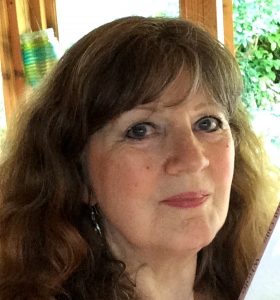

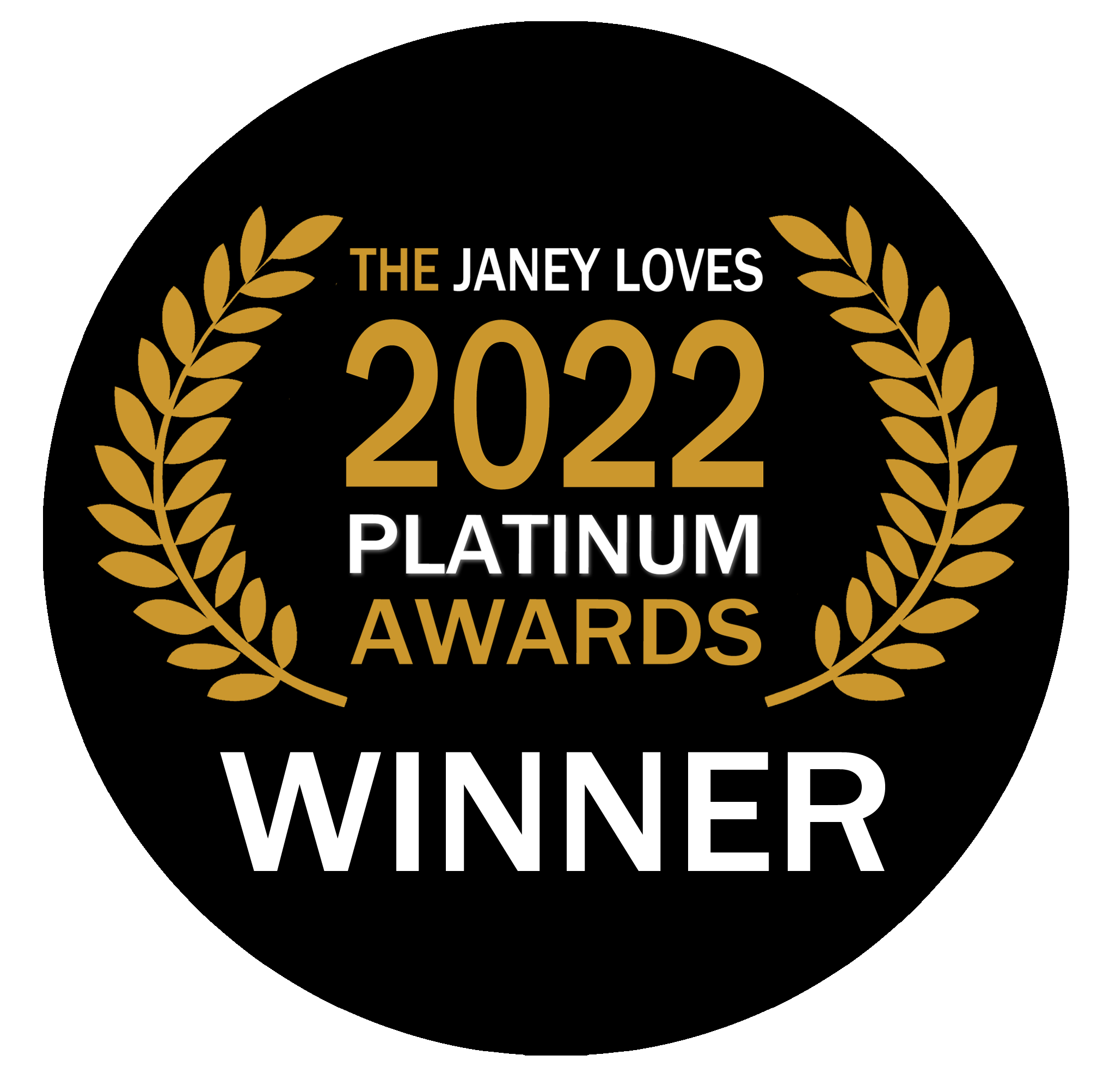



Ellen Kamhi Ph.D., RN, AHN-BC, RH(AHG), The Natural Nurse® has been involved in Natural Medicine since 1973, when she directed a program in Ethnobotany at Cochise College in Douglas, Arizona. Dr. Kamhi attended Rutgers and Cornell Universities. She sat on the Panel of Traditional Medicine at Columbia Presbyterian Medical School and is a Medical School Instructor, teaching Botanical Pharmacology. She was nominated for the March of Dimes, Woman of Distinction 2004 and received the J.G Gallimore award for research in science.
Dr. Kamhi is a professional member of the American Herbalist Guild (AHG), and is nationally board certified as an Advanced Holistic Nurse (AHN-BC). Ellen Kamhi is the author of many books, including Cycles of Life, Herbs for Women, The Natural Guide to Great Sex, WEIGHT LOSS-the Alternative Medicine Definitive Guide. Additionally, she co-authored with Dr. Eugene Zampieron in The Natural Medicine Chest and Arthritis, The Alternative Medicine Definitive Guide. She hosts radio shows daily, including on Gary Nulls Progressive Radio Network. Furthermore, she is regularly quoted in numerous mainstream media including NewsMax, Marie Clare, Globe, Latina, Self, Woman’s World, Prevention, Cosmopolitan and Glamour.
She is on the Peer Review Editorial Board of several journals/organizations, including: Alternative Therapies in Health and Medicine, Natural Medicine Journal, Natural Standard Database.
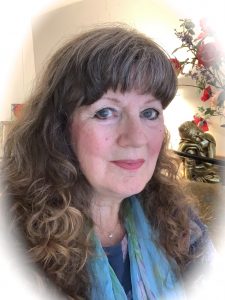
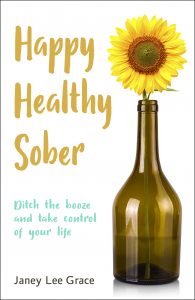 I am thrilled and honoured Janey asked me to contribute to her best selling new book, Happy Healthy Sober.
I am thrilled and honoured Janey asked me to contribute to her best selling new book, Happy Healthy Sober.
This is a lovely positive and upbeat book which explores ways to ‘ditch the booze’ and, in fact, other self-defeating habits we might cling to in order to ‘get through’.
Janey presents a candid overview of her own experience ‘ditching the booze’, sharing with the reader her struggles, but also, significantly, her incredible sense of liberation.
Janey reminds us that the locus of personal control is just one fulfilled intention away – that is, to value and love oneself. Taking control and exercising self-discipline is the ultimate paradox, the rewards are unimaginable; from the steel of resolve burst forth a multi-coloured fountain of possibility.
Shaking off the shackles of comforting, self-soothing habits, however, is not easy – the voice that insidiously whispers ‘just one more….’, ‘you’ve earned….’, ‘you deserve….’, ‘it helps me relax….’, ‘tomorrow…’, reassuring and conveniently persuasive.
But do not despair, Janey has this well covered (remember, she has been there too). Her thirty-day challenge, for example, supports the reader through the initial, often most challenging phase of sobriety. With her eye on the road ahead, she includes useful tips that cover all aspects of holistic wellbeing, from self-care, fitness, nutrition to mind-set and spirituality. There are tips from Sober Club members and contributions from health and wellbeing experts, including my section on the benefits of essential oils! Sobriety, after all, is a way of life, and, far from being restrictive and denying, is enlivening, even fun, as you will discover when you dive into Janey’s book.
Ditching the booze or not, this book offers invaluable insight and support that can be used to aid navigation through these very unusual and challenging times – for example, substitute the word ‘booze’ for any ‘addiction’ or self-comforting or compensatory habit, or simply absorb the words of wisdom and advice of a fellow ‘traveller’ finding her path through the challenges and the ‘up’s’ and ‘downs’ of life.
Heather Dawn: Godfrey. P.G.C.E., B.Sc. (Joint Hon)
Based in San Antonio, Texas, USA, radio hosts Marc and Nikki share their special interest in promotion of natural medicine and the significant role plants play in managing and maintaining health and wellbeing.
I was delighted to be invited as a guest to discuss with Marc and Nikki the many ways of applying the qualities of essential oils safely and effectively. We talk about both topical and internal application and explore appropriate application and the boundaries of use, and discuss the wonderful effectiveness of essential oils when they are applied diligently, focusing particularly on their anti-microbial and skin restorative and regenerative, and psycho-emotional properties.
The interview begins 10 minutes in to the show.
 Click here to listen to the interview
Click here to listen to the interview
Click here for more information about Marc and Nikki and their radio show
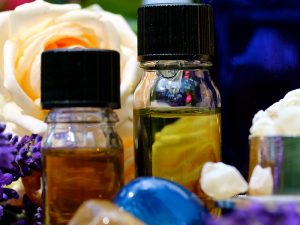 Click here for more information about how to apply and store essential oils safely
Click here for more information about how to apply and store essential oils safely
Click here for more information about what is an essential oil
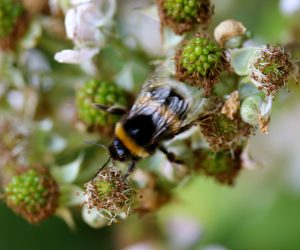
Heather Dawn: Godfrey. P.G.C.E., B.Sc. (Joint Hon) (Author of Healing with Essential Oils)
This article contains excerpts from my latest book, Healing with Essential Oils
The Role of Essential Oils within Plants
Essential oils occur as secondary metabolites in plant’s and, while not vital to the plants existence, they play a significant supportive role.
Exuding as an auric, enveloping, vaporous mist surrounding the plant, their volatile molecules create an environment that is one and the same time repelling to predators and harmful microbes, yet attractant to pollinating bees, butterflies, birds and animals. Essential oil molecules also relay signals to other plants, and modify the immediate environmental temperature to avert water loss.
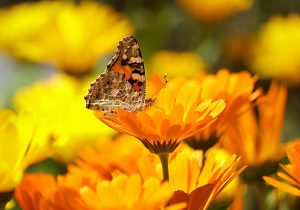
Within the plant they are ‘hormone-like’ and relay messages in response to changes in atmospheric conditions, tissue injury, damage or disease. They disarm invasive microbes, and stave infection and disease, while their tissue-regenerating properties heal and repair.
Essential Oils and their gifts to us
Animal and plant cells are similar. Indeed, we share a symbiotic relationship with plants, which, among other things, provide nutrients, medicines and oxygen vital for our survival. Essential oils lend us the qualities they gift the plant, and so much more. They are anti-microbial, protective, restorative and regenerative. They are also wonderfully sensual and hedonistic. They gracefully influence mood, emotion and spirit. They aid memory, clarity of thought and perception. They instil a sense of being grounded, uplifted, peaceful and vibrant. They may invigorate, brace and strengthen, calm and gently subdue. They rebalance and restore equilibrium.
And what about their perfumes!
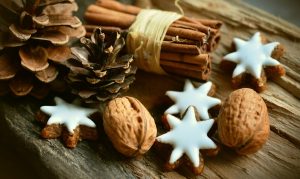 A wisp of scent is enough to immediately transport us on a sensory journey. A jasmine kiss on a starlit night; a rose garden on a dewy summer summer morning; the earthy-agrestic woodiness of a northern forest in spring; Mediterranean citrus groves in winter; a log fire on a cool dusky evening; spicy warm fruit cake fresh from the oven – sunshine on the cloudiest day. Tones, colours and shades, nuances that seamlessly imbue from conjured images, memories and impressions, complex and deep, often experienced beyond words, sensually illuminated by the gift of smell.
A wisp of scent is enough to immediately transport us on a sensory journey. A jasmine kiss on a starlit night; a rose garden on a dewy summer summer morning; the earthy-agrestic woodiness of a northern forest in spring; Mediterranean citrus groves in winter; a log fire on a cool dusky evening; spicy warm fruit cake fresh from the oven – sunshine on the cloudiest day. Tones, colours and shades, nuances that seamlessly imbue from conjured images, memories and impressions, complex and deep, often experienced beyond words, sensually illuminated by the gift of smell.
Truly, their qualities are numerous.
Essential oils can journey with us through the seasons, to protect and support us while we re-calibrate and adjust to changing conditions. They can be applied to create an ambient atmosphere, support meditation and relaxation, to aid concentration when 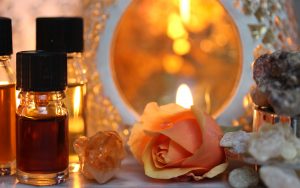 studying; indeed, scent detection immediately returns conscious awareness to the present moment.
studying; indeed, scent detection immediately returns conscious awareness to the present moment.
Their anti-microbial and decongestant qualities can alleviate the symptoms of colds and ‘flu (for example, peppermint, myrrh or cypress). Frankincense and myrrh, for example, are ‘earthing’, warming, drying, antimicrobial, they support the immune system, while they are also calming; an antidote to the cold the dampness of winter. Combined with bitter orange or another citrusy oil, they can at the same time dispel feelings of anxiety and depression. Mandarin and the earthy-smoky scent of vetivert, combined with the sweet rose-like scent of geranium express similar uplifting yet grounding qualities. There are so many essential oils to choose from, yet it just takes a few carefully selected oils to create your own scented pharmacopeia, bringing nature to your senses; let your intuition and nose guide your choice. Enjoy your journey!
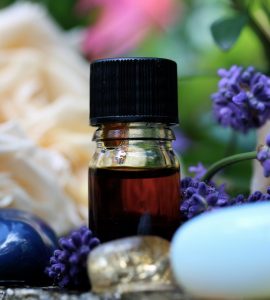 Applying Essential Oils
Applying Essential Oils
You can diffuse essential oils into the atmosphere or add them to a bath blended in a vegetable oil (to prevent skin irritation), or apply them in a roller bottle diluted in coconut oil or jojoba.
A word of advice: do not apply essential oils neat to your skin, always dilute them in an emollient such as non-perfumed cream or lotion, or a vegetable oil. Do not diffuse essential oils near an infant’s headspace as their respiratory systems are delicate and easily sensitised. Always check the therapeutic qualities of an essential oil before applying it.
Learning more about Essential Oils
My books, Healing with Essential Oils, Essential Oils for the Whole Body, and Essential Oils for Mindfulness and Meditation, provide details about blending, safe application, individual essential oil profiles and so much more – discover the alchemist within you.




 Heather Dawn: Godfrey. P.G.C.E., B.Sc. (Joint Hon)
Heather Dawn: Godfrey. P.G.C.E., B.Sc. (Joint Hon)
Where do I start? This seemed to be the biggest question, laden with the colours, shapes and shadows that suddenly burst into the foreground of my imagination. Yet, in the spirit of paradox, this was also the simplest, easiest question to answer… just do it!
Stripped back in the expression of this raw, uncluttered assertion, however, another, and probably the most significant, question was laid bare. Suddenly unveiled, free of the cloaking haze created by racing thoughts, confused hesitancy, procrastination, or even ambitious good intention, stark in its uncompromising nakedness the REAL question was: Do I absolutely, really, definitely, want to do it? Do I feel passionate and committed? Do I believe in what I want to do with all my heart, and with a level of conviction sufficient to fuel my tenacity during ‘stormy weather’, because no journey is ever filled with perpetual sunshine?
Juxtaposed, I stood at a crossroads. The opportunity before me may never visit again, putting it off until ‘later’ may not be an option – if I don’t do it now, I never will. There is never an absolutely ‘perfect moment’ (falsely fuelling procrastination, deceptively easing the choice to delay). There are always both reasons ‘to do’ and ‘not to do’. So it was, my mind and sensibility fused, the answer not purely logical, but passionate too, balance tipped, I took my leap of faith.
Even so, this was not a blind leap of faith. I carefully evaluated my situation, reviewed and planned my financial position to ensure I had sufficient funds, and created a realistic time frame within which to work. I had accumulated years of experiential and academic knowledge and had a wealth of information and insight to draw on. I grounded my ambition. And so, my journey began.
I started by reviewing the books of other authors writing about similar topics (what would I offer that was different, compounding, expanding), investigated their publishers, and other publishers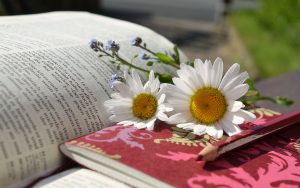 , and even considered self-publication (the choices seemed overwhelming). I drew up a list of possible publishers based on their compatibility with my subject genre. But first, before I could knock on anyones door, I had to have something tangible, a ‘product’ with which to gain their interest beyond a mere idea or imaginative concept. What would my book offer that others did not? What value would my work bring?
, and even considered self-publication (the choices seemed overwhelming). I drew up a list of possible publishers based on their compatibility with my subject genre. But first, before I could knock on anyones door, I had to have something tangible, a ‘product’ with which to gain their interest beyond a mere idea or imaginative concept. What would my book offer that others did not? What value would my work bring?
Everything contributes, is significant, to learning and comprehension (good, bad, positive, negative, mistakes, successes). Learning is a perpetual process. Experience, insight, knowledge and information form a web, each aspect a delicate thread connecting, contributing and shaping an intricate mutualistic network that captures the conceptual within its tangible form. Each thread is significant in its own right but is equally existent by virtue of attaching points that are subsequently built on and developed from.
My experiential journey, my intellectual comprehension, delving and questioning, my encounters with those I have met along my path and the messages they impart (teachers, experts, other authors, the magazine or journal articles read, conversations and deliberation with my peers or even a perfect stranger sat next to me in a cafe or on a train who I serendipitously share a conversation with), when spun together, form threads in the intricate web.
Who am I writing for?
My original decision to write was inspired by my clients and students – their enthusiastic, positive response to essential oils, their desire to learn and ‘grow’ their knowledge and understanding – and my own intrigued fascination as I observed the influence essential oils procure.
I work with a range of people in various contexts: as a therapist providing stress-reducing treatments to facilitating the learning of others (be they lay people, carers, therapists, or healthcare professionals). Thus, my objective was to create a practical yet sound foundation of knowledge aimed at the interested user of essential oils, student, and professional practitioner alike, a bedrock on which they could confidently continue to build and develop their own knowledge and experience.
I formulated a plan, a ‘map’ of the book, embracing the topics and subject area, which I organised into chapters (well, at least, the chapter titles and subheadings). Then I integrated a time frame into this map, setting targets and goals, to ensure I efficiently maximised my fleeting ‘window of opportunity’.
My first goal was to produce at least two or three chapters that would demonstrate the content, genre, and my writing style and skills. Even though I had already tested my writing ability through publication in related journals (the critique received from editors enlightening, invaluable, and supportive), the idea of producing a book seemed like jumping from a rowing boat to a ship.
Every writer has their own style of creative expression, but facts require delivery in universally comprehended dialogue. So, finding someone who would initially proofread for me was my next goal (a trusted friend who enjoys reading themselves is a reasonable starting point, although proof-reading does need to be done professionally later on). Objective feedback and critique sheds light on ‘blind spots’; we all have good and not so good writing habits, and perform better on some days and not so well on others.
The process of writing…
 I love writing, or, rather, I love words, their ‘colour’, meaning, and the pictures and images they create. However, in spite of my comprehension, imagination and verbal fluidity, writing does not come easily to me. Ideas, words and images abound in my imagination, dancing in my minds-eye, presenting a picture, but somehow seem to scatter chaotically in translation from thought to page.
I love writing, or, rather, I love words, their ‘colour’, meaning, and the pictures and images they create. However, in spite of my comprehension, imagination and verbal fluidity, writing does not come easily to me. Ideas, words and images abound in my imagination, dancing in my minds-eye, presenting a picture, but somehow seem to scatter chaotically in translation from thought to page.
I did not realise I was dyslexic until I was in my forties; I had simply assumed until then that I was not ‘very bright’ academically, especially as my early years at school often saw me in remedial groups because my spelling and writing were ‘behind’ that expected of my age group. Consequently, I absorbed a sense of being ‘stupid’ or ‘not very clever’ which affected my self confidence; although I did excel with almost exhausting effort toward the end of my schooling.
Objective feedback and critique sheds light on ‘blind spots’; we all have good and not so good writing habits, and perform better on some days and not so well on others.
Aware I need to work alongside my dyslexic trait, I compensate by integrating extra time that allows me space; for example, to work in ‘bursts’ and step away when my brain is saturated. Words pour forth, scatter onto the page and I have to re-read, correct and re-correct their order and flow, my spelling and grammar often erratic; words omitted or repeated twice, letters missed from the beginning, end or middle of a word, and often in the wrong order. My brain quickly becomes exhausted.
I write fluently by virtue of my ‘word processor’; my handwriting, although quite neat initially, quickly deteriorates into illegible scrawl after a few sentences, that even I cannot decipher. My notes quickly become chaotic, here and there, a messy ink splodge of crossing-outs, insertions and additional notes, aborted attempts and new starts, scribbled in various random note books and on spare pieces of paper, thoughts and ideas desperately captured before they disappear through the gaping net of my short-term memory. When I read, words can play tricks, disappearing or transforming into something else that my brain quickly reconstructs to compensate for their illusiveness. The effort required to work through this trait exhausts my brain and I sometimes, quite literally, cannot keep my eyes open and have to sleep, even just for five minutes. In this context, to write a book at all is at one and the same time inspired ambition and a huge challenge.
Being dyslexic, though, does not impede my awareness, imagination or ability to comprehend or communicate, and while ‘voicificying’ and translation of words into coherent written sentences is often problematic, it is not impossible. I find myself, as a consequence, exploring words more deeply, absorbing the colours and resonance of their meaning. I love the art of writing. In order to publicly write, even so, I had to let go of my self-defeating sense of clumsy imperfection, of not being ‘good enough’ – it’s ok for this to walk alongside with me, my shadow companion, but not to fall, like a self-fullfilling sacrifice, beneath my feet, tripping and arresting my steps. This is my journey.
Finding a publisher…
 Once the first chapters were complete, reviewing my list of potential publishers, I resumed my search. In view of my dyslexic trait, self-publication did not seem a sensible option. However, scrolling the internet, reviewing my choice of publishing companies, their background details and requirements, I again felt overwhelmed. They were all very similar in their requisite of prospective authors (the information they required, the non-committed assertion that a response could take several months and then with only a slight possibility of acceptance), but with little information about the author’s position. When I telephoned to enquire “what happens when a manuscript is accepted for publication”, the only answer I received was “it depends”, or “I will put you through to so-and-so who will answer your query”, and I found myself endlessly dangling ‘on hold’, my questions unanswered.
Once the first chapters were complete, reviewing my list of potential publishers, I resumed my search. In view of my dyslexic trait, self-publication did not seem a sensible option. However, scrolling the internet, reviewing my choice of publishing companies, their background details and requirements, I again felt overwhelmed. They were all very similar in their requisite of prospective authors (the information they required, the non-committed assertion that a response could take several months and then with only a slight possibility of acceptance), but with little information about the author’s position. When I telephoned to enquire “what happens when a manuscript is accepted for publication”, the only answer I received was “it depends”, or “I will put you through to so-and-so who will answer your query”, and I found myself endlessly dangling ‘on hold’, my questions unanswered.
I discovered that many renowned companies, although maintaining their individual ‘front cover’ identity, in fact, have been absorbed, taken over, by a handful of very large corporate organisations whom generally only accept manuscripts forwarded by an agent.
None of the information I gleaned or the responses to my enquiries I received filled me with any confidence. I could not risk sending my precious manuscript to a publisher who potentially would not respond for several months, especially given, by their own admission, the high possibility of rejection. Neither could I risk, for obvious reasons, sending my manuscript to several publishers at the same time to see who would accept my work. The time, effort, sacrifice and cost could not be justified through such an approach.
So, I reviewed the list again, specifically asking myself, ‘who can I trust to nurture and guide my effort, give constructive support and feedback, progress my book from draft to finished book ready for market?’
I decided to begin locally, and discovered a small ‘eco-friendly’ publishing company who appeared to tick all the right boxes. In deed, their exuberant, slightly over-the-top, sales pitch was persuading. They eagerly assured me they possessed the necessary ‘techno geek’ (their term) qualifications and professional experience to evolve my manuscript from written word to publication format. They produced examples of books they had already published, and enthusiastically confirmed they would be ‘delighted’ to publish my work. So, believing I had ticked the next box on my list, I set to and completed my manuscript.
However, the over-enthusiastic introduction, boasts and assurances of professional skills extolled by this company, crumbled to dust amongst the debris of meetings, attended but detail and objectives not followed through or nonchalantly deferred (their dynamic enthusiasm apparently withering, assertions and promises forgotten immediately, it seemed, on our departure from each other). The missed deadlines, unanswered emails and phone calls, the long uncomfortable silences, backed up against their door.
Two years from our first meeting, without consultation, contract implied but still not signed, and clearly flouting professional protocol, they published my work ‘over my head’, without consultation or preview, to my utter horror (they even billed me for the cost of this publication fo par). They incorrectly configured my work, deconstructing tables into plain text, making numerous unforgiving errors in the process (their professed professional expertise, a shattered illusion, shards of broken glass stabbing my ambition). Needless to say, we parted company, my book withdrawn from their possession, publication immediately arrested. Distressed and deeply disappointed, I seriously questioned my judgement. Choosing to believe their zealous rhetoric (as this is all it was, in the end), I ignored the warning signs, and, although I would not have predicted their ultimate audaciousness, like it or not, this experience forms part of my story, my journey. Let my lesson also teach you (as it uncomfortably did me) something about self-worth and the subtlety of collusion.
“Challenges are gifts that force us to search for a new centre of gravity. Don’t fight them. Just find a new way to stand.” Oprah Winfrey
Karma is a simple concept or principle, an objective process; cause and effect, we simply reap what we sow. And so it was (and is) for me. Although I do not take responsibility for their behaviour, I do take responsibility for my own. I did keep my end of the bargain and worked diligently to produce and promote my work to the best of my ability, delivering everything I promised. However, I learned a valuable lesson about the law of attraction and self worth, about not having the courage to ‘speak out’ sooner, or to stand up for and believe in myself and the value of my effort and ability. Our interaction should have ended when they glibly confessed to loosing my drawings, or after the first (of three) promised but missed publication deadlines, or when my gut screamed anxious warnings within me as we parted company from meetings. Yet, I allowed my self-doubt and sense of feeling small to obscure my better judgement. Thus, I colluded.
Good publishers respect their readers as well as their authors and produce books that people want to ‘own’, add to their collection, read and keep to re-read and lend to friends and family.
Dice shaken and thrown, I landed on the square that sent me sliding back to ‘go’ (and some). My search for a publisher began again. After much reflection though, this time, I found the courage to seek a publisher ‘I deserve’ and not one ‘good enough for me’. Oprah is right when she says, “You get in life what you have the courage to ask for.”
 I signed a contract in the summer of 2017 with Inner Traditions, Bear & Company, a well established professional American ‘eco-friendly’ (determined not to let my previous experience shatter all my belief) publisher with a proven track record for delivering well presented books in my genre, among others (as their publication catalogue testifies).
I signed a contract in the summer of 2017 with Inner Traditions, Bear & Company, a well established professional American ‘eco-friendly’ (determined not to let my previous experience shatter all my belief) publisher with a proven track record for delivering well presented books in my genre, among others (as their publication catalogue testifies).
Indeed, there is no comparison with my previous experience. Their ‘eco-friendly’ stance is actually grounded within a sound, proficient, thereby sustainable, business model. Extremely efficient and proactive, with clearly defined guidelines and boundaries, there is no ambiguity. Promises are kept, deadlines are met, communication is maintained, the author becomes ‘part of the team’, each an expert in our own field, and nothing is progressed without approval. Simple, yet proficient! My experience of working with Inner Traditions is, to my relief, extremely positive, and I have absolutely no reason to doubt that it will continue to be so; the adage ‘actions speak louder than words’ echoes, hauntingly rings, within me as I make this statement.
 My first book, Essential Oils for Mindfulness and Meditation, was published Autumn 2018, an award-winning, best selling new release, and was also published in Traditional Chinese in 2019. My second book, Essential Oils for the Whole Body, was published Autumn 2019 and also won an award (the Janey Loves Platinum Award 2020), and was also is also published in Traditional Chinese. My third book, Healing with Essential Oils, was published summer 2022, again, winning the Janey Loves Platinum Award 2022.
My first book, Essential Oils for Mindfulness and Meditation, was published Autumn 2018, an award-winning, best selling new release, and was also published in Traditional Chinese in 2019. My second book, Essential Oils for the Whole Body, was published Autumn 2019 and also won an award (the Janey Loves Platinum Award 2020), and was also is also published in Traditional Chinese. My third book, Healing with Essential Oils, was published summer 2022, again, winning the Janey Loves Platinum Award 2022.
So, you see, actions do speak louder than words, and, in spite of the entropy that pulls at the threads of our (my) faith and self belief, self confidence, tenacity and hard work do pay off in the end. I may not be a Pulitzer prize-winner (well, I couldn’t be anyway, apart from anything else, I’m British!) but I have happily reached my own mountain top with a deep sense of gratitude for the support and encouragement I encountered, and for the lessons I learned along the way!!!!



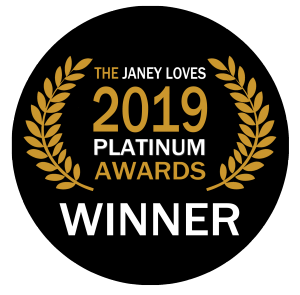



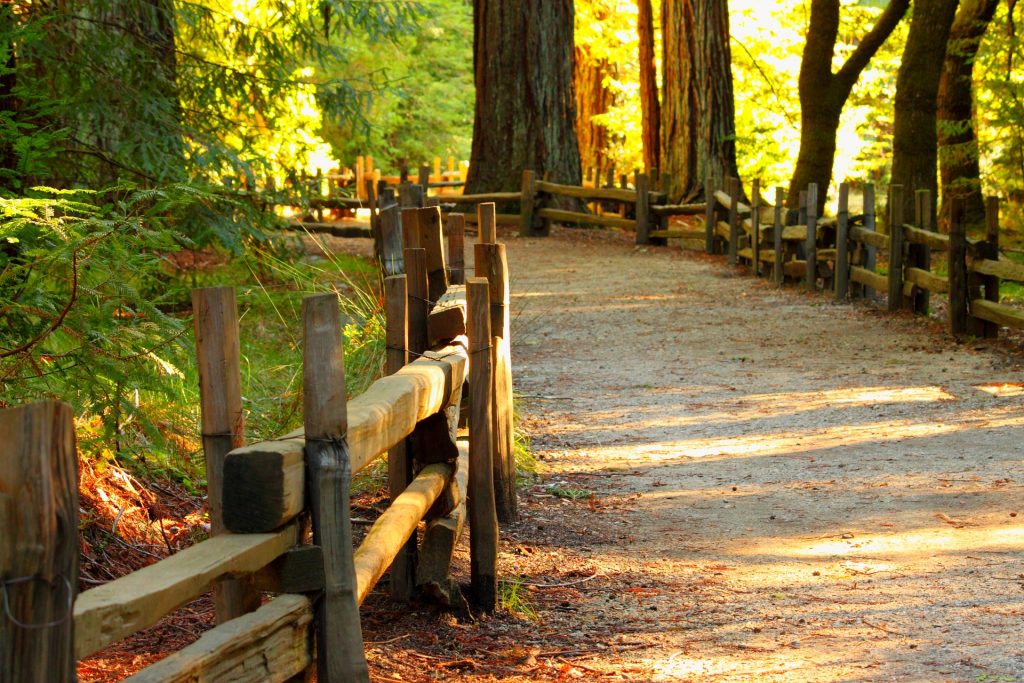
As affirmed in my recent blog, ‘Grateful Reflection’, one of the lovely unexpected consequences of setting out on my writing journey is that I encounter so many amazing and inspiring people. It is so uplifting to realise just how many kindred spirits exist. In sharing a little bit about them here, I aim to let their stories touch you too. We learn so much from each other. There is a synergistic quality that evolves from connecting and sharing; mutually enlightening, supportive, and strengthening.
I am doing things I have never done before, as the journey pushes my boundaries, and eases me beyond my comfort zone. One such thing is participating in radio interviews; it appears this is imperative for authors if they are to promote their work and reach out to as wide an audience as possible (writing, although hard work, is also very safe and insular, and somehow my ‘walls’ have insidiously retracted to create an increasingly small and comfortable space).
When my publishers publicist emailed me to invite me to participate in a live radio interview, was I ‘up for it’, my immediate response was, ‘Oh yes, of course!’ Then the realisation of my assertion swept through me, a flush of anxiety suddenly stopped me in my tracks. ‘What was I thinking of?’. The floodgate opened, sweeping every fragment of my self confidence and self belief away from me in it’s gushing path. My inner voice echoed in my mind, ‘what if….you’re not….you can’t….who do you think you are….??!!’
I was sooo nervous when the day arrived. Palms sweating, heart racing, I picked up the receiver, the telephone an instant convenient connection to the radio station across ‘the pond’ in New York. The producer ‘counted me in’, we were live on air (no pressure…..). A deep breath…
I was so relieved when I returned the phone to it’s charging station in the kitchen; I did it, I survived, somehow I found my words, they did not desert me. I felt exhilarated. A simple but significant feat. I’d climbed another mountain and reached the top, exhausted by my fearful anticipation, but so relieved to have ‘arrived’ in one piece. Time for a cup of tea!
But I meditate! How can I feel so unconfident, self doubting, insecure, anxious? Is it my watery star sign, my sensitivity? No matter, it is as it is, as it has been all my life. I have learned to navigate through my life, accepting this trait, my anxious sensitivity, as my companion and not my enemy. Meditation, my best and most trustworthy friend, takes my hand and comforts me as it leads me to the safe stillness at the centre of my beating heart, accepting of, embracing, every part of me.
Then there are the people I meet, whose light lights my light, who touch and inspire my spirit, energise my purpose: and the story unfolds………
Essential Oils for the Mindfulness and Meditation (Inner Traditions, Bear & Co., Vermont USA)

Essential Oils for the Whole Body (Inner Traditions, Bear & Co., Vermont USA)

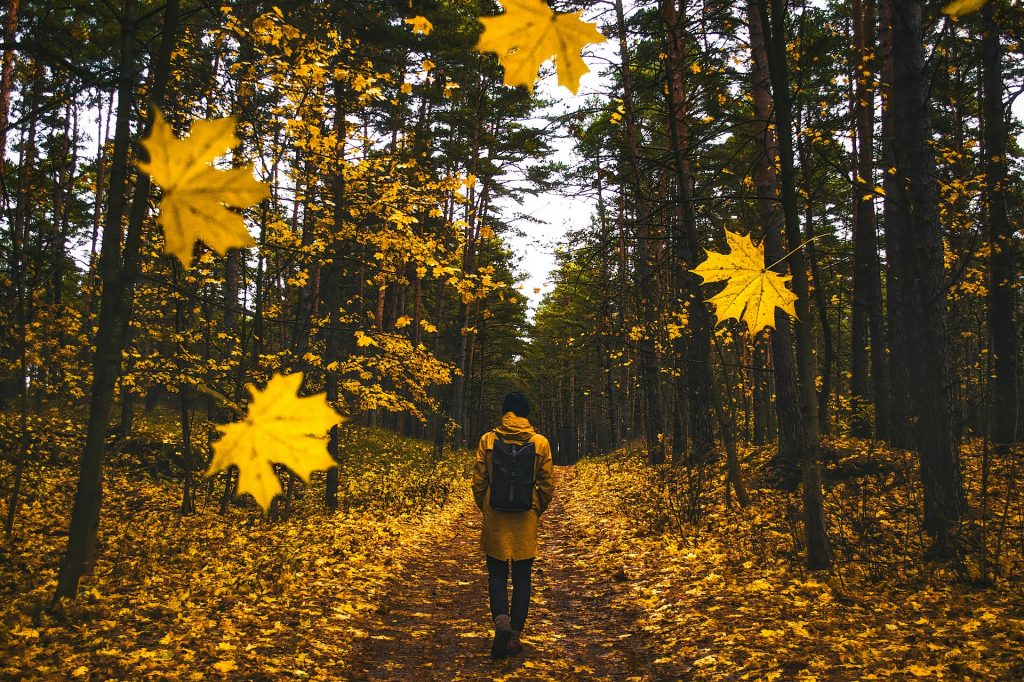
Age is an inevitable process; our bodies are finite, life is transient. However, although there is some inevitable ‘slowing down’, ageing does not necessarily herald debilitation. Ageing is another of many ‘rights of passage’ encountered through life.
Marguerite Maury (1895-1968) believed that in acknowledging age as a natural process, a friend and not an enemy, adapting and not giving up in the face of inevitable change, viewing age as ‘another country visited’ along the journey of life, we thus equip ourselves to enjoy it as a new, exciting untapped landscape, still holding adventure and possibility. Such an attitude, she believed, staves off premature cellular deterioration, which lays the ground for disease and diminishing faculty, keeps us ‘alive’ and vibrant, and enables ability to adapt and deal with challenges. She eloquently delves into the subject of ageing in her book ‘The Secret of Life and Youth’ (1964):
Our main interest is not old age in itself, the accomplished fact… what we have to know is what causes it to take us by surprise… growing old is an eminently individual matter… there are as many ways of growing old as there are human beings… each ageing according to his body, heredity, biological make up, mentality and, finally, evolution. (Maury 1961: 1989, p. 19)
Maury observed the interconnectedness between mind, emotion, body and nature and the dynamic role essential oils may play as regulators that are capable of maintaining, healing, restoring, balancing, and linking ethereal, spiritual and physical dimensions – sustaining the organisms dynamic vibrancy and vitality. She was particularly interested in the similarity in composition of human and plant cells and their life cycles and restorative ability, especially in relation to human tissue, recognising “the innate kinship” between the cells of living organisms and their dynamic integrated relationship with each other:
Nature is sovereign: the plant is a living being with a specific energy potential. The use of this energy conforms to the law of nature… By inserting this energy force into our body, we can therefore expect an efficacious and selective action on its part. The body will thus have at its disposal a vital and living element. It will use its energy for its own ends. The great physician Ramon considered odoriferous matter as a vegetable hormone, the only one to be in a dynamic state. (Maury, 1961/1989, p. 80 & 81)
In deed, essential oils do offer a vital natural connection between man’s external and internal environment, their virtues supporting and regulating physiological and psycho-emotional health, wellbeing and sense of spiritual awareness; perfect companions (along with meditation). Applied appropriately, essential oils are safe and cost effective. They are dynamic. They complement the changing needs of the body and procure protective, restorative and rejuvenating qualities.
Frankincense, patchouli, cypress, carrot seed, rose are among many essential oils that offer valuable support – psycho-emotional, physiological, immunological, and skin care.
My books, Essential Oils for Mindfulness and Meditation, and Essential Oils for the Whole Body, explain the various dynamical qualities of essential oils and how they support wellness and wellbeing.
Meanwhile, please visit www.aromantique.co.uk for information about the safe use and application of essential oils.
The basic elements that support health and wellbeing as we age:
To read the full article and for references visit:
http://www.aromantique.co.uk/articles/essential-oils-and-ageing-the-autumn-years/
To learn more about essential oils:
Essential Oils for the Whole Body
Essential Oils for Mindfulness and Meditation

The journey from idea, pen to paper, to publication.
“You become what you believe, not what you think or what you want”. Oprah Winfrey
The readers experience of a book is as significant as its academic and/or creative content. Good publishers respect their readers as well as their authors, and produce books that people want to ‘own’, add to their collection, read and keep to re-read and lend to friends and family.
Getting a book published is not an ‘overnight’ process; patience and tenacity are significant requisites. And, while self motivation and a willingness to proactively promote your own work are a ‘must’, a certain degree of humbleness is also required to manage the ‘reality checks’ along the way.
Publishing is not a journey anyone can make entirely alone and synchronising the right support is as significant as writing the book in the first place (among other things, even for those who self publish, finding a good ‘proof- reader’ is an absolute must…..the truth is, no matter how proficient a writer, we all have ‘blind spots’ when it comes to our own work).
I have learnt so much, and continue to do so, as I travel through the process – the journey of learning and discovery is ongoing.
Your living is determined not so much by what life brings to you as by the attitude you bring to life; not so much by what happens to you as by the way your mind looks at what happens. – Khalil Gibran
This is the first book I have published, so I am still a novice, and my experience is limited. However, if I were share any advice based on what I have learned so far, it would be this:
My leap of faith has brought many challenges but also many pleasant surprises and, as my publishing journey continues to unfold, I am sure there will be many interesting and exciting encounters, learning curves and revelations yet to transpire.


